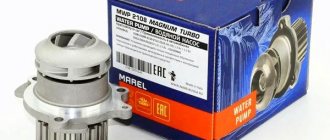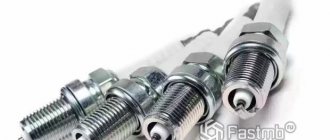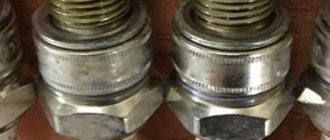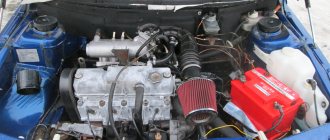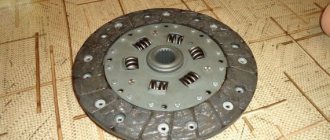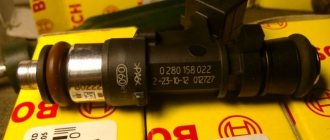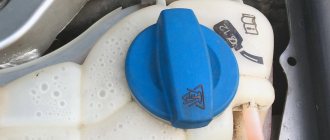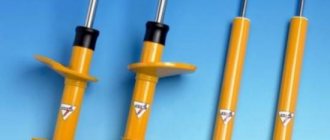The cooling system of the VAZ-2114 car is a complex mechanism of various parts and mechanisms, and the basis for everything is a water pump or simply a pump. This mechanism rarely fails completely, but problems associated with its stable operation occur periodically. Therefore, every VAZ-2114 owner needs to know which pump to pay attention to if the old one has exhausted its service life.
The video below discusses the issue of choosing a pump for the VAZ-2108 (the engine pumps for the VAZ-2114 and 2108 are identical):
Below we will tell you about the main problems that occur when a water pump breaks down and which manufacturer to pay attention to when purchasing.
What can a pump breakdown cause?
As already mentioned, the pump (or pump) circulates all the coolant in the system. If it stops working, the fluid circulation will stop. Such a malfunction can lead to very serious consequences, including:
- boiling of coolant in the system (this can mainly be observed in the expansion tank);
- rapid engine overheating;
- damage or even destruction of the engine and adjacent units (if the engine runs for a long time without cooling).
Overheating of the VAZ 2114 engine As you can see, the breakdown of such a small device as a liquid pump can lead to engine failure, and repairs in this case will cost much more. For this very reason, you should periodically check the performance of the pump and, if a malfunction is detected, replace it immediately.
It is quite rare for a pump to completely fail; much more often you can observe its operation with interruptions caused by wear of internal parts. Such a pump should be replaced immediately, without waiting for it to stop completely, because it no longer creates proper coolant circulation.
You can quickly check whether the pump is working correctly as follows:
- Start the car and wait until it warms up.
- Place your palm around the upper hose in the radiator area.
- Squeeze the hose with enough force to feel whether there is a pulsation of liquid inside it.
- If pulsation is present, then the liquid is circulating and the pump is working properly, but if there is no pulsation, then most likely the pump is faulty and should be replaced.
[custom_ads_shortcode1]
What happens if the pump fails?
Pump wedge, resulting in timing belt break
Inspection of the pump must be carried out regularly, since the entire circulation of coolant in the system depends on its condition. It is brought into working condition mechanically, that is, with the help of a timing belt, which is also connected to the generator. Accordingly, if it breaks down, the movement of the coolant stops and the antifreeze begins to boil in the tank. Not only does the car engine overheat very quickly, but problems may also occur with the transmission of voltage to the system.
Which pump to choose
Before replacing a broken pump with a new one, you should think about which pump is best to install on the VAZ 2114. This is due to the fact that different manufacturers produce pumps of different quality, and not all of them will be able to work properly for a long time.
According to the opinion of the majority of motorists, based on the practical use of pumps from certain manufacturers, it is better to give preference to pumps from the following companies: They have shown themselves to be the best, ensuring uniform circulation of fluid in the system and having the longest service life.
[custom_ads_shortcode2]
Signs of a pump malfunction
If the pump does not work, what signs indicate this? Let's list them in order:
- frequent engine overheating, especially in warm seasons;
- the pump’s seal is broken; coolant leaks will be visible from under its body (this is especially clearly visible when antifreeze with a fluorescent element is used);
- the smell of grease coming from under the water pump bearing;
- a sharp sound that comes from the pump bearing impeller;
- The heater in the cabin stopped working, provided that the engine was warmed up.
The listed signs indicate that the pump needs to be changed unscheduled, and the sooner the better, because if it jams, then the timing belt will also have to be changed. or even engine repair may be needed. In parallel with this, additional diagnostics must be performed in order to check the condition of other elements of the engine cooling system.
How to check for a malfunction
Having talked about which pump is better for the VAZ 2114 8 valves (and therefore which one will need to be purchased in the event of a malfunction), let’s also talk about what signs can be used to understand that the liquid pump has failed. The most likely factors indicating a malfunction are:
- rapid drop in fluid levels in the tank. It may indicate the presence of leaks in the system, which can form in a variety of places - joints, pipes and even the radiator itself;
- presence of liquid at the ventilation hole. It indicates that there are leaks in the pump seal area;
- humming sound when the liquid pump is running. Most often it speaks of partial wear or even complete destruction of the bearings;
- destruction of the pump impeller (the most obvious factor, although its presence can only be established after dismantling and disassembling the old pump);
- presence of deposits on the oil seal. Plaque itself does not indicate wear or breakdown, but is one of the indirect factors pointing to it.
Old and new VAZ 2114 pump If you notice that at least one of the above signs has appeared in the car (except for the last one), then you should not wait until the pump completely breaks down - it is better to replace it as soon as possible.
It is worth noting that you can detect a malfunction of the cooling system right on the go - to do this, you need to turn on the heated air blowing into the cabin and wait a little. If the air starts to flow warm, then everything is fine, if it is cold, then there is no fluid circulation in the system.
[custom_ads_shortcode3]
When to change your pump
The following signs will indicate the need to replace the water pump:
- During warm periods of the year, engine overheating often occurs, although the antifreeze level is normal.
- There is a leak at the pump connection points or the drain hole.
- While the motor is running, extraneous noise is heard from the pump (knocking, rustling, crackling, etc.).
- In winter, the heater does not heat up even with a well-warmed engine.
Also consider the service life of the part of a specific model. For most cars, this is a mileage of 60–90 thousand km. In rare cases it reaches 120 thousand. It is recommended to replace the pump after its service life has expired.
Replacing the Fluid Pump
After you have purchased a new pump for the VAZ 2114 (which is better - mentioned above), you should install it. For this you will need:
- Turn off the engine (if the machine is running) and wait until the system cools completely.
- Disconnect the terminals from the battery and remove the drive belts.
- Drain the liquid from the system using a plug bolt (before doing this, remove the cap from the expansion tank).
- Remove the timing belt by first unscrewing the bolts on the protective cover and removing it. (Important! After the belt is removed, it is strictly forbidden to manually turn the crankshaft or camshaft).
- Remove the old pump (sometimes dismantling it may require some effort, since the original pump is additionally fixed with sealant).
- Degrease the surface after sealant (for example, acetone).
- Install the new pump and reassemble in reverse order.
By performing these simple operations, you can quickly install a new pump and return the car's cooling system to normal operation.
[custom_ads_shortcode1]
Any car parts can deteriorate over time. Despite the fact that the water pump is a durable and reliable device, it can also become unusable. As you know, nothing lasts forever, so over time the pump needs to be changed or repaired. In case of serious damage, it is advisable to replace the pump with a new one, which will serve properly for many years. It is very important to purchase a high-quality and durable part.
[custom_ads_shortcode2]
Types of water pumps
The main tasks performed by a car water pump:
- constant maintenance of a stable temperature in the engine cooling system;
- equalizing sudden temperature changes in the system;
- ensuring continuous movement of antifreeze.
Regardless of car models and engines, all pumps are similar in design, and may differ only in size, mounting method, performance, and impeller type. However, based on the impeller, pumps are divided into two categories: plastic and metal. All of them have both their disadvantages and advantages.
How to choose a pump by impeller type
The vast majority of modern pumps have impellers made of plastic. The main advantage of a plastic element is its significantly lower weight compared to metal ones, and, accordingly, lower inertia. This means the motor spends less time spinning the impeller. More often, plastic impellers are installed on so-called turbo pumps and have a closed design.
But plastic impellers are not without their drawbacks. And the main one is deformation under the influence of high temperatures of antifreeze. Over time, during their operation, they change shape, and the efficiency of the entire pump is lost. In addition, they can simply be torn off the rod and the impeller will begin to scroll. Most often concerns budget pump options.
Regarding metal impellers, their main drawback is their high rate of inertia. But unlike plastic ones, it does not change shape and does not wear out over time. Budget pumps sometimes show signs of corrosion, especially when using low-quality antifreeze or ordinary water in the cooling system.
Consequently, the decision about which impeller to choose for the pump remains with the car owners. It is worth noting that most manufacturers install pumps with plastic impellers on modern cars. However, only high-quality materials are used for them, so there are no signs of abrasion or deformation over time.
Choosing a pump for the VAZ-2114
When purchasing a water pump it is very important:
- Carefully inspect the part and assess the condition of the metal and all connections.
- It is advisable to compare several options to see the difference. In general, low-quality products are immediately noticeable.
- Next, it is important to pay attention to checking the blades and the angle on the side where the pump is attached to the engine block.
- There are four pump options: Gates, Luzar, TZA and HEPU. Luzar and TZA are in great demand among car enthusiasts. They have a long service life, are silent and durable. TZA are sold with a cork gasket, so they are more popular. When purchasing, it is advisable to check with the seller the characteristics of all types of pumps, and make your choice based on this. If you are not well versed, then ask the seller for advice, be sure to name the make of your car, and then he will select the appropriate option for you. You need to purchase only in specialized stores, where all parts have a guarantee.
Rating of the TOP 7 best pumps for VAZ
To understand which pump on the VAZ model is better, it is recommended to make a rating. The following is a table that lists the instances from last to first.
| № | Name | Performance | Supply voltage | Current consumption | Nozzle diameter | Length |
| 7 | TZA 2107130701075 | 160-170 l/min | 12V | 0.3V | 32 mm | 210 mm |
| 6 | Dolz L120 | 160 l/min | 12V | 0.3V | 32 mm | 210 mm |
| 5 | HOFER HF033024 | 170 l/min | 12V | 0.3V | 32 mm | 210 mm |
| 4 | Metelli 24-0833 | 170 l/min | 12V | 0.3V | 32 mm | 210 mm |
| 3 | FENOX HB1001L1.1 | 160 l/min | 12V | 0.3V | 32 mm | 210 mm |
| 2 | LUZAR 21124-1307010 | 170 l/min | 12V | 0.3V | 32 mm | 210 mm |
| 1 | Bosch 0392020024 | 180 l/min | 12V | 0.3V | 32 mm | 210 mm |
TZA 2107130701075
The TZA pump, applicable to the VAZ-2107 and other classic models, is one of the available options on the market.
A sealing gasket and a passport are supplied with the product. The packaging is branded, there is a protective sticker. The product is assigned a unique identification number.
The impeller of the pump is made of plastic and has 7 blades.
The reviews note a small resource, play appears quickly. It is not recommended to install this pump on cars with a 16-valve engine. If a part jams, there is a high probability of serious repairs.
Source
Who to pay attention to
As a standard, VAZ cars are equipped with a pump manufactured by TZA. It is relatively good and can last quite a long time, but not all users are satisfied with its quality. An alternative solution could be Luzar. A trusted manufacturer that supplies pumps that are ideal for AvtoVAZ products. If you need a pump for a long time, Luzar may be a good solution.
If you prefer devices from foreign companies, it’s time to stop at SKF. A good option, characterized by an excellent price-quality ratio. Please note that you should not buy HEPU products. Its pulley is simply not suitable for Priora cars. A cheap but short-lived option would be Coram. This is a Chinese company that supplies inexpensive but very mediocre pumps.
Distinctive features of the new TZA pump from a fake
This review will involve 3 pumps from TZA - the Togliatti Automotive Units Plant, which produces spare parts for VAZ cars.
Two of them are original TZA pumps, and one is a fake. 2 pumps are original and a fake - an old model, they have an old impeller, they are no longer produced at this time. Pumps with impeller 2114 are now available; the impeller blades are sharp, not rounded , as on conventional pumps.
The fake pump in our review was given to us for a while to review. Previously, the TZA logo was on the pulley, on the sprocket, and on the plastic impeller, somewhere near the blade. The manufacturer's logo remains on the impeller. And on the pulley of the new pumps there is now laser dot marking. The old water pumps had a simple factory logo stamped on them. The fake is very similar to the original, now fakes of the new model have begun to appear - with sharp blades, with everything as it should be. But there are distinctive features, and they will be useful to you.
On the fake, there is no factory logo on the pulley ! And on the impeller there is.
What are the distinctive features of these pumps? The old-style packaging should no longer be on sale ; pumps in such boxes have not been produced for 2 years. These are either remnants or they are old remnants of fakes. There shouldn't be an old-style impeller with rounded blades either.
The purpose and general design of the pump in the Lada Priora car
An auto water pump (VP) or pump is structurally included in the liquid cooling system (LCS) of a modern car and is its key element. The main function of this part is to ensure intensive circulation of coolant (coolant) through the engine's fluid circulation system.
Thanks to this constant movement, the temperature of the liquid decreases and its ability to cool other parts and systems of the car is restored. As a rule, the water pump on a car engine is structurally located in front of the cylinder block. Its drive is carried out from the crankshaft through a special wedge-shaped belt or from the gas distribution mechanism (timing) using a toothed belt.
A special toothed belt ensures the functioning of the car's water pump.
General pump structure
The Lada-Priora pump is a fairly simple mechanical unit, which consists of several main parts.
The pump design consists of several elements, one of which is the obligatory gasket
The main components of an engine water pump are:
Operating principle of the device
The operation of the coolant pump is as follows:
- with the engine running, the coolant that has cooled in the car radiator moves to the pump (in particular, to its impeller);
- the gaps between its blades are completely filled with coolant;
- due to the action of centrifugal force, the coolant is thrown by the impeller into different directions of the internal cavity of the HV;
- through the technological hole, the liquid goes into the channels of the cooling jacket of the motor elements;
- constant circulation of the cooling medium in the liquid cooling system is ensured.
Design Features
To prevent possible leakage, the pump body is installed on the engine cylinder block through a special gasket (for example, made of cardboard). The cooling fan, which is sometimes structurally located on the car pump pulley and driven simultaneously with it, is usually made of metal or durable plastic. To reduce operating noise, the blades of the structure are located at certain angles, in an X-shaped position, which corresponds to 110/70 degrees.
In order to reduce the power required to drive the fan, designers use a special electromagnetic clutch. This device can turn off the fan when the coolant temperature drops to a level of 78–85 degrees Celsius. In this way, the operation of the engine cooling system is optimized, and the noise level during operation of the unit is also reduced.
The original or the Chinese equivalent is half the price: we disassemble and compare water pumps
A little history
Let’s start with a short reminder of what a pump (or water pump) is, why it’s “watery” if there’s been antifreeze splashing in the cooling system for a long time, and why it sometimes has to be changed. At the very beginning of the existence of cars, the cooling system was elementary - open. And there were no pumps there, the system was a thermosiphon: hot water, according to all the laws of physics, rose to the top, cold water flowed down, all this slowly circulated, and everyone was happy. We were happy, but not very happy, because the water consumption was enormous. Due to the fact that water was simply poured into an open tank, it evaporated very actively. Therefore, a logical step was taken: to make the water cooling system closed. The water in it cannot evaporate quickly, which means it does not need to be constantly topped up. And it was also necessary to invent a radiator, because the conventional coil, which was used at the very end of the 19th century, was not efficient enough. At first, he coped with his work in a closed system, but complaints against him remained. Moreover, the system remained a thermosiphon system - without a water pump. Only at the very beginning of the 20th century did the very detail appear that gave the system an almost modern look - the pump. She is also a water pump. The task of the water pump was not difficult, but very important: to drive water inside a closed loop. That’s why the pump was called a water pump, since there was nothing but water in the cooling systems at that time. And since in essence it is an ordinary pump (usually a centrifugal one), the name remains the same: water pump. I'll call it a pump for short. Over time, pumps have become more diverse. Some have “learned” to listen to ECU commands, but most budget cars with simple engines still drive with rather primitive pumps. As a rule, they are quite enough.
What and how?
So, the task of the pump is clear to us: to force the coolant to circulate in the cooling system. It does this quite simply: the impeller drives the flow of antifreeze from the radiator to the block. The drive of the pump can be different, but the most popular is a belt. Most often - by the timing belt, but sometimes it is turned by the serpentine belt of additional units. In theory, this is a fairly reliable unit. But still, it has to be changed periodically. Like any other mechanism with seals and bearings, it wears out over time. At best, the pump begins to leak a little, at worst... There are different options. Wear of the bearings first leads to an unpleasant squeaking noise, which is most often very audible on a cold engine, but disappears as it warms up. If you do not respond to it in any way, the pump may jam. And this is already sad, because if the pump is driven by a timing belt, the latter usually cuts off the teeth, which often leads to valves and pistons meeting on “plug-in” engines. If the pump is driven by a belt of additional units, the consequences can also be bad. For example, it happens that due to the pump jamming, the engine simply stalls at idle - it grabs it too hard by the belt, which, of course, is rotated by the crankshaft pulley. It’s especially disappointing that computer diagnostics in this case will not show anything: there are no errors in the engine, its systems or sensors. And he still stalls. Another unpleasant failure scenario is the failure of the impeller blades. This happens for various reasons. If the blades are metal, they will corrode over time. True, car owners are often to blame for this process because they forget that antifreeze needs to be replaced at least once a decade and there is no point in pouring slurry into the cooling system, which is sold on the market “brotherly” for a hundred rubles. A healthy antifreeze means a healthy pump, so to speak. Plastic impellers simply wear out. And if they are made by the playful hands of a huckster from an underground workshop, they wear out very quickly, causing bewilderment to the car owner who has just installed such a pump. If the impeller wears out, the symptoms of failure will be as if there is no pump at all: the motor gets hot, and in advanced cases it can even “steam”. To make sure that it is the pump that is to blame, a method that has become popular among VAZ owners is suitable: on a warm engine, pinch the pipe coming from the radiator with your hand. If there is no pressure in it, the pump is dead. For other breakdowns there will be more work. You'll have to at least inspect the pump. If it is in antifreeze, it will also have to be replaced. In addition, you need to make sure that it is level. If the bearings in it have already died, the pulley may be slightly misaligned. The same thing happens if some not very decent craftsman stuck a new pump to a dirty mating surface. Unfortunately, in our imperfect world, where Feduk sings and Kristina Asmus stars, such things happen regularly. By the way, if the pump is leaking, you can smell antifreeze. It is so specifically sweet that it is impossible not to recognize it. Before disassembling the pumps and looking at their insides, I’ll say one more thing: pumps often die due to all sorts of stop leaks that are poured into cars with leaky radiators. Risk is, of course, a noble thing, but not always reasonable.
Three from the casket
There are three pumps in front of us. Just out of curiosity, we took these: the original pump from AvtoVAZ (21120130701082), the little-known G-Part product (2112-1307010) and the most affordable Chinese pump from Gallant. All of them are suitable for VAZ 2110, 2111 and 2112 with a 16-valve engine. Let's see what these pumps are. Let's start with the original. After all, this should be the standard, and all other pumps should be the envy of it.
I won’t discuss the box – the box is just a box, nothing interesting. Let's move straight to the pump.
If you don't look closely, there is nothing strange about it. The impeller, by the way, is plastic.
If you start looking more closely, there are some comments. Firstly, it was still not done very carefully. For example, there are burrs sticking out everywhere on the chamfers. However, this, as they say, “does not affect the speed,” and you shouldn’t find fault with it.
But the second remark is very significant. Gentlemen, you can’t do the pulley that drives the timing belt like that!
I wonder if you buy ten VAZ pumps, will this defect be repeated on at least one more? I hope not, but seeing this on an original part is a little painful. Well, let's take it apart.
Let's start by removing the shaft bearing retaining screw. This requires a hexagon, but there is nothing complicated in the process itself.
Then the pump is also very easy to disassemble. Using a puller, we pull off the pulley, then with the same puller we easily squeeze the shaft towards the impeller. There is no additional fixation of the pulley and bearing, so anyone (who has a puller) can do it. As a result, we get a separate housing, pulley and shaft with a bearing and impeller.
The inside of the pump looks even better than the outside. Everything is quite neat. It’s good that the shaft bearing is fixed with a screw and not with sealant: it’s convenient to disassemble. True, it is not clear why to do this: if the pump dies, it is easier to install a new one than to try to repair the old one.
As you can see, there is nothing complicated inside the pump. And yet it sometimes requires replacement. It is impossible to estimate the bearing life by eye, but you can say something about the original pump.
The advantages include a high-quality case that easily survived disassembly, ease of disassembly itself, and generally good quality of surface treatment that requires it. The disadvantages are a rather obscene attitude towards those surfaces that are not adjacent. They just had a bolt hammered into them. This is probably the result of finding a compromise between price and quality, so there’s nothing to complain about either. This approach is acceptable. But knocked down edges of a pulley gear are a serious problem. It will certainly affect the life of the timing belt, because these strange notches not only change the relief of the tooth in height (which can be survived), but also protrude beyond the dimensions of the tooth in width. This means the belt will wear out. It is unacceptable. We can only hope that this marriage is an isolated incident. The second pump is the Chinese Gallant. A very funny product, to be honest.
It looks good from the outside. The impeller is metal.
The quality of processing also looks decent, although the ends of the pulley teeth are not processed very carefully.
Everything glitters and sparkles so that you can’t take your eyes off it. But let's try to take it apart.
It seems to be similar to the original, but it’s not. Let's look at the body.
It began to fall apart even at the stage of removing the pulley, although the puller does not touch the body at all during this process (it holds the pulley with its paws and presses into the shaft). As soon as I pressed the body in a vice a little, a piece fell off of it. “Perhaps I overdid it,” I thought. Just for fun, I took some pliers and... broke off another piece of the body. Then more. In general, I don’t know what this case is made of. Something like pressed foil.
Structurally, the pump also differs from the original. There is no screw that secures the shaft bearing. The shaft is sitting on some kind of blue sealant. And it sits very firmly. It is impossible to pull it out, as on a VAZ pump towards the impeller: a ledge is cast inside the body into which this shaft rests. Therefore, you first need to remove the impeller and push the shaft from the bearings towards the pulley. We broke the housing anyway, so we didn’t spare the pump and pressed out the shaft with a hydraulic press in the same way as on the VAZ pump. At the same time, the hull was broken, but there was nothing to lose.
The layer of sealant was not pleasing: in some places it was thick, in others it was empty.
The advantage of the pump is the cost. It cost us 772 rubles, but the original one cost 1,602 rubles. The difference is obvious.
The downside is the quality of the case, not very high-quality assembly. I could also add something about the inability to quickly disassemble it, but I won’t. This, as I said, is no longer relevant for a long time, and the pumps are replaced as a whole. The third pump is interesting because it is packaged under the g-part brand, which is still unknown to me. The box differs from the previous two at least in its higher quality printing and the fact that it is glossy. This has absolutely no effect on the quality of what’s inside, but I have a kind of warm relationship with glossy boxes. Probably in a past life I was a magpie and loved everything shiny. But it's not as interesting as a sticker with a part code. With its help, you can check the authenticity of the part on the g-part website. It's a small thing, but nice.
If the part is genuine, then it has a two-year warranty. Also good. But we are more interested in what lies inside.
And inside there is a regular pump. There are no questions about her appearance. The pump is very similar to the one we bought for 772 rubles: the workmanship is also of very good quality and the impeller is also metal.
The processing of the pulley teeth also does not raise any questions: there are no burrs, much less dents, as was the case on previous pumps.
Let's take it apart. Structurally, this pump is the same as the previous one: it is difficult to disassemble, and we only did it with the help of a press. You can also remove the shaft only towards the impeller, and not the pulley, as on the VAZ pump.
There is also no locking screw here, and all the parts just fit tightly. However, the housing turned out to be much stronger than the housing of the cheapest pump. They even completely disassembled it: they removed the pulley, the impeller, and the shaft with the bearing.
1 / 3
2 / 3
3 / 3
It’s even strange, but there are no questions about this pump at all. Despite its origin, its body turned out to be strong, and its assembly was quite decent. The puller and press left scratches on the body, of course, but nothing fell apart.
What's the result?
Of course, it is impossible to evaluate a part without a full life test. But even the minimum that we saw during disassembly of the pumps (and in the case of the VAZ pump, without disassembly, but directly on the pulley), allows us to draw some conclusions. Only one pump cannot get a positive rating - this is Gallant for 772 rubles. It breaks too easily with pliers. Maybe, of course, it will serve, but it doesn’t inspire confidence at all. True, it costs, I repeat, a penny. The original is good, but its reputation was greatly spoiled by the notches on the pulley teeth. Apparently, quality control is not the company's strong point. However, if you at least carefully inspect this pump before installation, there should be no problems. A significant disadvantage is the cost of 1,602 rubles, which is more than two times more than the first Chinese product. More precisely, a Chinese craft. I’ll go into a little more detail here. It is likely that this pump would have shown its best side in a resource test. But we all know about the “plug-in” nature of modern engines. So the timing belt is sacred to them. The pump started whistling - I replaced it and forgot about it. But if the belt breaks... In general, even an external examination allows us to draw some conclusions. The g-part pump is the golden mean. There seem to be no complaints about the quality: the body is durable, looks neat, and is well assembled. The kit, like previous samples, includes a gasket. The cost of the pump is 1082 rubles, which is noticeably more interesting than the VAZ part. Of course, I would like to check how it would behave in a bearing test, on which the life of the pump mainly depends, but, alas, today we have the wrong format. But if you try to evaluate the pump based on external parameters, then I would probably install this particular pump. Well, or the original, if I found a non-defective part.
DIY pump replacement
Removing the VAZ 2114 pump
The replacement process depends on how many valves are in the car's engine. An 8-valve engine has one crankshaft pulley, a 16-valve engine has two, therefore the system is organized differently. By the way, a pump for an 8-valve engine will not work for a 16-valve engine and vice versa.
If the sign of a pump malfunction is the timing belt wear, then you need to check the condition of the tensioner roller. If there are signs of rust, it is better to change it too. If there is no lubricant under the sealing rubber, or there is not enough lubricant, the supply must be replenished. It is also worth checking what degree of wear the alternator belt has. Although its unexpected break is not critical for the car, changing the belt on the road is a dubious pleasure, especially if there is no spare one.
Replacement process on an 8-valve VAZ 2114
- Remove the timing belt protective cover.
- Loosen and remove (if necessary) the tension roller.
- Loosen the generator, remove the generator and timing belts.
- Disconnect the hoses from the pump and drain the coolant.
- Remove the protective cover and pump.
After removal, you need to thoroughly clean the surfaces of the pump flange and cylinder block from dirt and stuck gasket residues. The growth of a mud “beard” is one of the reasons for the pump being skewed and the timing belt being eaten away.
To avoid leaks, the gasket must be thoroughly coated on both sides with red sealant.
After replacing the pump, it is necessary to set the timing marks: the crankshaft may move relative to the camshaft.
Causes of pump malfunction
The reasons for partial or complete failure of the pump may be:
- impeller failure;
- large play in attaching the pump to its seat;
- jamming of working bearings;
- reduction in the density of sealed connections due to vibration;
- initial defect of the product;
- poor quality during installation.
Car water pumps are irreparable, so in the vast majority of cases, the car owner is forced to face the issue of completely replacing the pump with a new one.
The best timing drive and pump
The thorny path to replacing the timing belt and rollers has been completed, along with the water pump (coolant pump). It became thorny, firstly, due to the fact that for two years or 25 thousand kilometers I drove with a belt installed by the previous owner, which involuntarily destroyed the stereotype that car salesmen can no longer be trusted. He was a normal guy, he said to replace it in the spring, I replaced it two days later... The old belt, by the way, proudly demonstrated by the master (“Christina”), at the time of replacement, turned out to be cracked at least one of the teeth. The pump has also suffered over the past years - the play was no less proudly demonstrated, and upon leaving the service center I personally noted a decrease in the noise level from under the hood. The replacement of the latter was dictated more by the expediency of combining work than by real suspicions of an imminent end. The 124th engine does not bend the valves when the belt breaks, it was possible not to worry, but... perfectionism is a serious disease.
After all, thorniness is also due to the specifics of the choice of spare parts. I mean it's hard. And this is what was replaced (price + delivery cost): - INA timing drive kit
(Slovakia) - 1390+600=2000 rub.
// alsport.ru According to the website “ Used in motorsport.
Improved timing belt design from INA. Instead of neoprene, enriched nitrile is used, because When heated, neoprene becomes rigid and loses its elasticity. "
— coolant pump TZA Sport
(Togliatti) - 503+325=828 rub.
//nbklada.ru “ Produced as a modernization of the pump 21120-1307010-75
(only this is presented in Virazh, and at a price of 730 rubles - note theo51ab)
for 16-valve internal combustion engines of Kalina cars and other front-wheel drive cars "VAZ".
Design features: — New 8-blade impeller 21118 with a modified profile and direction of the blades, productivity above 170 l/min for use in internal combustion engines operating with increased loads; — Cassette type oil seal made in Italy; — Bearing made in Slovakia. This allowed: - to increase pump productivity by 20-40%; — improve the operation of the internal combustion engine cooling system; — improve the operation of the vehicle’s interior heating system; — increase the working life of the pump by 40%.
«.
The pump change was also marked by a replacement of the coolant - there is no need to skimp on antifreeze after last year's problems with antifreeze - AGA Z42 antifreeze
(10 liters of potion);
SCT fuel filter
(unfortunately there was no Knecht Mahle);
10W40 MotorGold oil
(5 liter canister, manufactured in 2012 - not only can this oil be bought in only two stores in the city, but also their 12th year can be considered a fresh batch...)
with a Knecht Mahle filter
;
oil seal
closest to the headlights due to detected fogging (Balakovo, FPM tires). Total: 960+130+(1100+130)+100=2420 rub. The total cost of the work was 1900 rubles. Some expensive update came out(
Source
